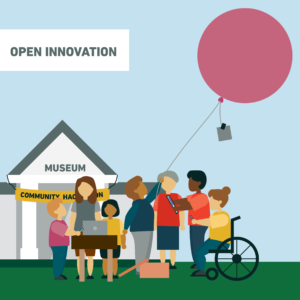
Open innovation approaches can include community science attributes and outcomes in creating opportunities for communities to engage in shaping and conducting research, participating in—and contributing to—technology and societal innovation, and ensuring that solutions benefit the communities they come from.
Open innovation refers to a set of approaches that organizations, companies, and governments use to invite solutions to difficult challenges from sources outside their immediate team, firm, or agency. Henry Chesbrough, one of the pioneers in defining open innovation, has said, “[The open innovation paradigm] assumes that firms can and should use external ideas as well as internal ideas, and internal and external paths to market, as they look to advance their technology.”1
Open innovation can also be described as a set of tools, approaches, and programs that help community members from diverse sectors and backgrounds join forces to make a breakthrough in finding solutions to difficult problems in science, technology, and society. They are “open” because many different people can join in on a mission to create a solution, including individuals and organizations from universities, government agencies, nonprofits, companies, and anyone interested in the solving the problem.2 This is in contrast to “closed” innovation, which is when a company or other organization assigns a particular set of people in the organization the task of inventing something new and only the people assigned the task work on it.
Open innovation can incorporate community science into different stages of the research and problem-solving phases. Some open innovation events are led by research, government, industry, or other organizations but include communities in helping shape the problem definition, as well as methods and testing of solutions.3, 4 On the more active side of community science, open innovation can also be more community-initiated and/or community-led, either overall or at particular stages of the open innovation event. For example, communities can design and organize the event, conduct their own data and research for problem solving, and implement and iterate on the solution.
1H. Chesbrough, Open Innovation: The New Imperative for Creating and Profiting from Technology (Boston, Massachusetts: Harvard Business School, 2006).
2McKinsey & Company, “‘And the winner is…’ Capturing the promise of philanthropic prizes” (McKinsey & Company, 2009).
3U.S. Government Accountability Office, “Open Innovation: Practices to Engage Citizens and Effectively Implement Federal Initiatives” (U.S. Government Accountability Office, October 2016).
4Raymond Tong and Karim R. Lakhani, “Public-Private Partnerships for Organizing and Executing Prize-Based Competitions” (The Berkman Center for Internet & Society at Harvard University, June 11, 2012).